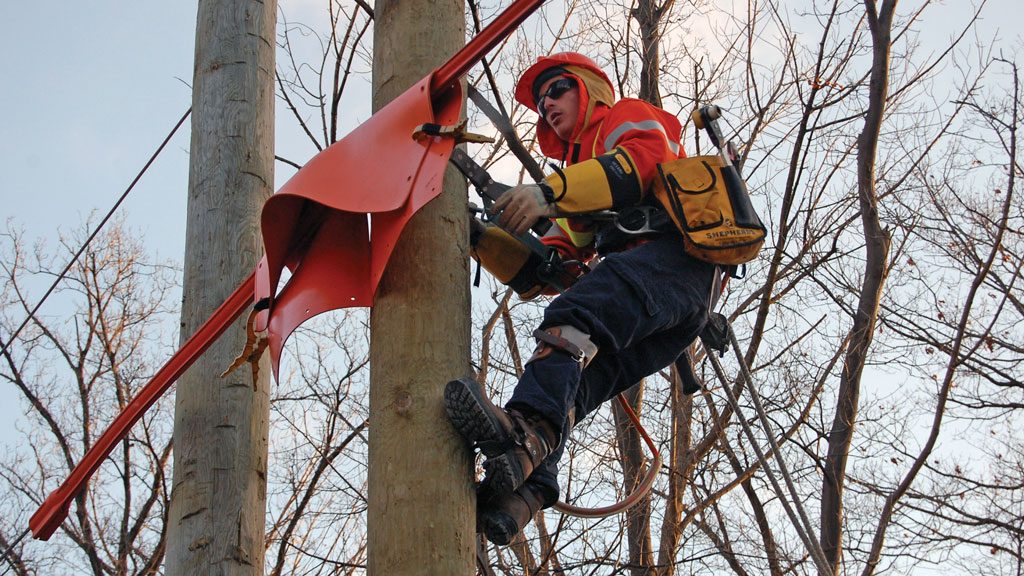History isn’t covered in the Powerline Technician Apprenticeship Training offered by the Infrastructure Health & Safety Association (IHSA) at its Skills Development Centre in Mississauga.
In a very real sense, however, the history of that training reaches back to the early part of the 20th Century when a very high industry death rate led to the creation of the Electrical & Utilities Safety Association of Ontario in 1915. In 2010 that organization merged with the Construction Safety Association of Ontario and the Transportation Health and Safety Association of Ontario to form the IHSA.
“If you and I were entering an apprenticeship in 1915 only one of us would reach retirement age,” says powerline apprenticeship and training manager Dennis Smith, in providing a chilling profile of the precarious nature of the work at that time.
Geared to electrical contractors and local distribution companies and taught to the Ministry of Training, Colleges, and Universities’ training standard, (434A) the training consists of four two-week sessions — or Levels — which are interspersed within the 8,000-hour apprenticeship.
At the heart of the training is the need for working safely using approved utility industry methods, says Smith.
All the apprentices are required to have at least three months of experience with their employer and completed five days of self-directed study before admission to the first level.
Restricted to a maximum of six participants, the sessions are taught by fully qualified powerline technicians with more than 15 years industry experience and who are qualified to teach through IHSA internal programs.
Upon entering the program trainees receive a colour-coded trade skills log book detailing the set of skills which must be required at each level through a combination of classroom and “real job” field training using an array of equipment such as transformers, poles, and aerial lift trucks.

“Although conducted in a controlled environment we try to emulate real life conditions linemen have to deal with — not just live wires — but also traffic and pedestrians,” says Smith.
As just one example, he cites the use of construction warning signs.
Some of the subjects covered in Level One include emergency plans, job planning, pole line construction, rescue techniques, and stringing, terminating, and splicing underground cables.
Every apprentice must successfully complete between six to 10 “practical tasks” worth 50 per cent of their grade, pass a written exam, and achieve an overall mark of 70 per cent to enter the next session. Their marks are digitally entered into the Ministry’s portal to be recorded as part of their apprenticeship.
As the apprentices progress to the next level, the training becomes more complex.
Each day begins with a classroom session, followed by the field work, and then a return to the classroom to review what has been learned that day.
To ensure each apprentice “assumes and demonstrates responsibility” the day begins with the selection of a lead hand whose oversees a prescribed task that aligns with three rules from the Electrical Utility Safety Rules. The following day they are required to provide a post-job report “on what went right and what went wrong.”
Considered the “bible” of the powerline industry and embedded in the Occupational Health and Safety Act, the IHSA/ Hydro One publication documents almost 150 safety rules, many with several clauses or sections.
Every five years the manual is updated and the most recent version will be released this month (February), says Smith, a member of a joint IHSA/Hydro One committee responsible for the revisions.
In addition to the apprenticeship training, the IHSA also offers a five-day Powerline Technician Proficiency program which is basically a refresher for licensed technicians. Consisting of more than 35 modules, it can be custom-design to meet the specific needs of employers and are usually conducted on or near their facilities in any part of the province.
Both the apprenticeship and the proficiency program are just one small component of the courses taught at the Skills Development Centre, emphasizes Smith.








What about helicopter training, history would say that there is a need for more experience and training when planning a job. If you have four people die after just receiving their C of Q you would have to recognize a void in the way training and experience play a role in keeping young Canadians alive.